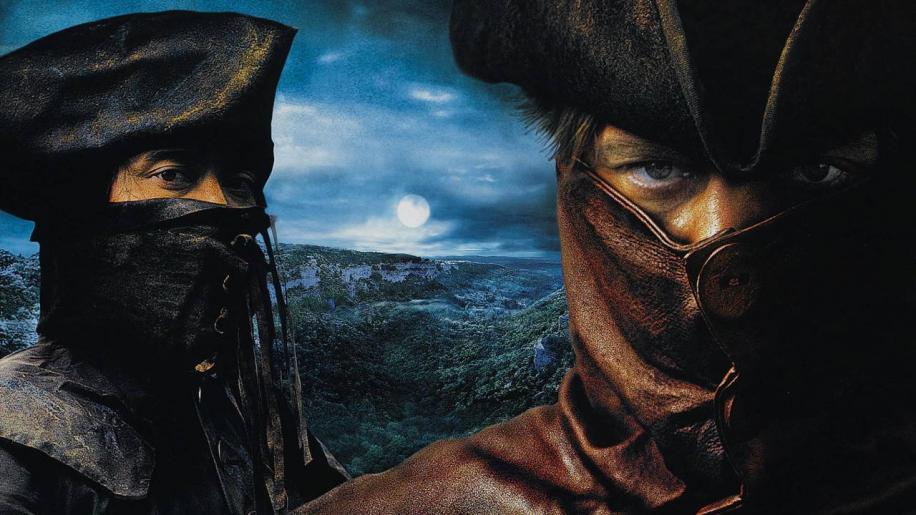“I hate it when people say, ‘I hate subtitles’,” John Waters laments in This Filthy World. “I love them! Even white subtitles in snow movies I like!”
There’s little snow in Christophe Gans’ Brotherhood Of The Wolf but there’s an awful lot of subtitles. But if you are one of those people who doesn’t go much on foreign accents and book learning, I sincerely believe this might be the film to cure you. For while it might superficially resemble many a classy Euro production, Brotherhood Of The Wolf (aka Les pacte des loups and to be referred from hereon in as BOTW) is one of the most insanely entertaining pictures ever made anywhere. A voracious monster with a basis in truth; a Native American tracker who’s also a martial arts whizz; heaving breasts; buckets o’ blood; a dash of incest – it’s like all the good seasons of Game Of Thrones squeezed into a brisk 142 minutes.
But don’t just take my word for it. A huge hit on the continent, BOTW so impressed the people at Universal, the US studio shelled out $2 million to secure the North American distribution rights. Gans’ picture wound up taking over $11 million dollars in that market, making it the sixth highest grossing French-language film in the US. Globally, BOTW grossed over $70 million. It also did brisk business on both video – remember video?! – and DVD/Blu-ray.
What was it about the film that caught the money men’s imagination? Beginning during the French Revolution with the Marquis d’Apcher (Jaques Perrin) concluding his memoirs ahead of his date with Madame Guillotine, Gans’ movie flashes back to find the young Marquis (Jeremie Renier) confronting a different kind of terror. The year is 1764 and in the province Gévaudan, something is killing people – a lot of people.
So many locals have been devoured by what they believe to be a wolf that Grégoire de Fronsac (Samuel Le Bihan), a knight who’s also naturalist to Louis XIV, is sent to investigate. Since the number of victims is big and only getting bigger, de Fronasc brings a friend along to help him – Mani (Mark Dacascos), an Iroquois tracker with experience in the Eastern fighting arts.
In seeking to put an end to the killings, de Fronsac and his ally encounter Marianne de Morangias (Monica Bellucci), the stunning daughter of a local nobleman and the sister of Jean-Francois (Vincent Cassel), an explorer and hunter whose exertions have left him with a withered arm.
To say much more would be to ruin the picture for those who’ve yet to see it. Let’s just say that the monster de Fronsac is chasing is something out of the ordinary and its existence is linked to a secret society bent on destroying the crown, the titular Brotherhood Of The Wolf.
If at least some of the above sounds familiar, that might be because BOTW‘s inspired by real events. The Beast of Gévaudan is now widely believed to have been a wolf-dog hybrid that killed at least 60 and perhaps as many as 500 people in the Margeride Mountains between 1764 and 1767. Nicknamed ‘the Napoleon Bonaparte of Wolves’ due to the length and savagery of its reign, there’s long been speculation about whether more than one animal was responsible for the deaths and whether the hysteria created by the slaughter meant more killings were attributed to the beast(s) than was truly the case.
Whatever the facts of the case, the Beast of Gévaudan was but a leaping off point for Christophe Gans, a fortysomething French director whose reputation for action and fantasy stemmed from 1993’s HP Lovecraft’s Necronomicon and 1995’s Crying Freeman, the martial arts movie upon which he also served as fight choreographer and during which he became acquainted with Mark Dacascos, a Hawaiian actor proficient in Muay Thai, capoeira, and Wun Hop Kuen Doe, a hybrid martial arts devised by his father Al Dacascos.
Brilliantly charismatic and totally kickass as the taciturn Mani, it should be pointed out that Dacascos doesn’t dominate BOTW. Nor does leading man Samuel Le Bihan even though his is a hero well worth cheering for. No, Brotherhood Of The Wolf is an ensemble piece, one so well written it attracted the interest of European film power couple Bellucci and Cassel. And, my, what fun the two have, Cassel in particular ringing everything out of a role he only agreed to play providing it was made even weirder.
What makes BOTW truly remarkable, however, is the fact that each element of the film would succeed even if the others were removed. A compelling period political drama; a genuinely suspenseful horror picture; an action flick that kicks ass the way few Hollywood movies do; a monster movie with a highly original and largely well-realised beast – if Gans’ picture is more than the some of its parts, it’s only because each part is stronger than steel.
Since so much is so good about BOTW, it’s a pity its writer-director has worked so sparingly since. Christophe Gans has in fact completed but two films since calling time on Mr Wolf; the 2006 video game adaptation Silent Hill and 2014’s Beauty And The Beast, with Vincent Cassel quite excellent in the latter role.
But while there’s now talk of Netflix and Blumhouse Productions taking a fresh swing at the Beast of Gévaudan affair, you’d think one look at Brotherhood Of The Wolf would be sufficient to make them think otherwise. A great advert for the everything-and-the-kitchen-sink school of cinema, Gans’ picture is so ridiculously entertaining, you could imagine it being outlawed in some quarters.
Put another way, whatever you think European cinema is, Brotherhood Of The Wolf isn’t. Prepare to be dazzled. And be sure to bring some silver bullets…









